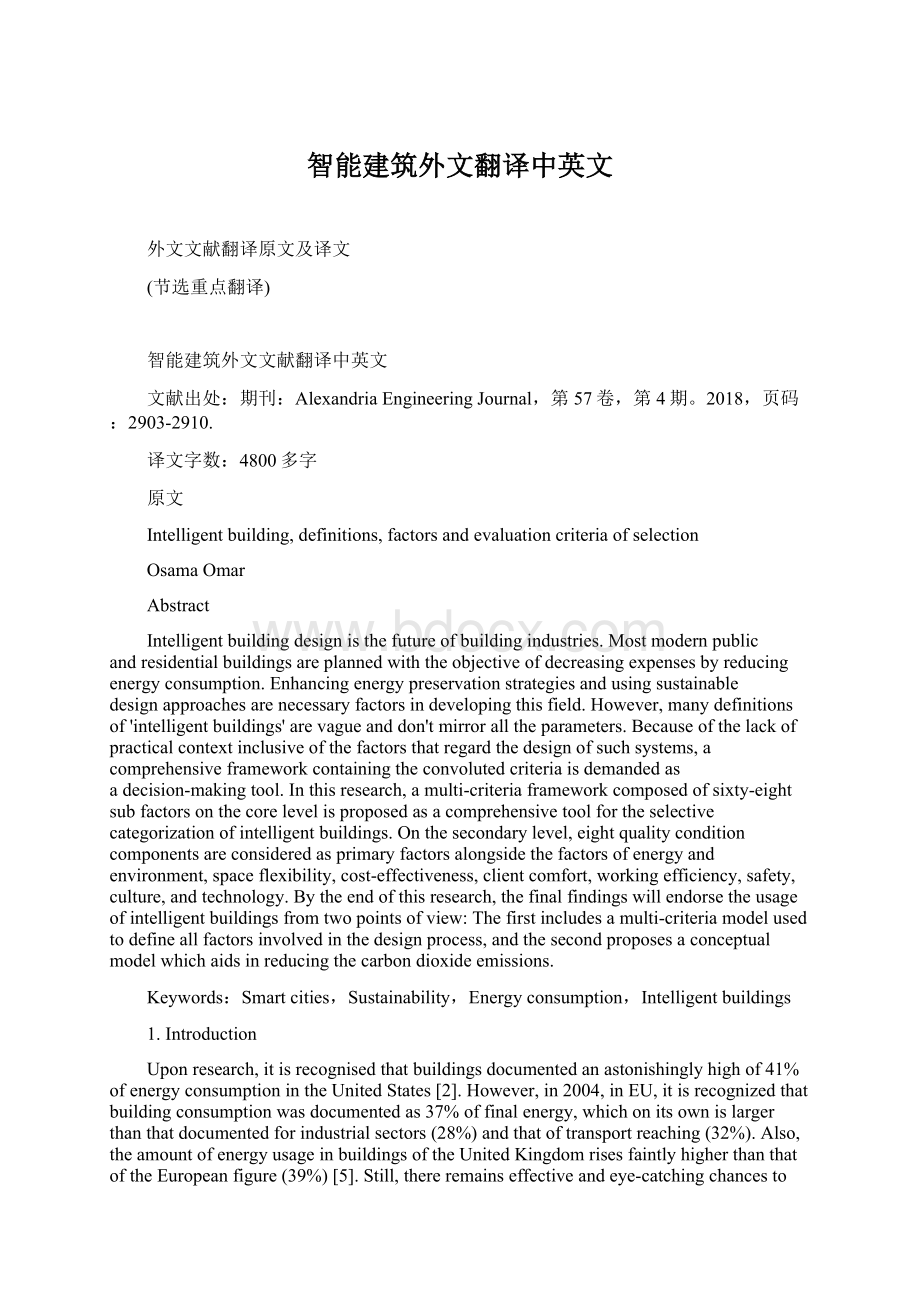智能建筑外文翻译中英文.docx
《智能建筑外文翻译中英文.docx》由会员分享,可在线阅读,更多相关《智能建筑外文翻译中英文.docx(11页珍藏版)》请在冰豆网上搜索。

智能建筑外文翻译中英文
外文文献翻译原文及译文
(节选重点翻译)
智能建筑外文文献翻译中英文
文献出处:
期刊:
AlexandriaEngineeringJournal,第57卷,第4期。
2018,页码:
2903-2910.
译文字数:
4800多字
原文
Intelligentbuilding,definitions,factorsandevaluationcriteriaofselection
OsamaOmar
Abstract
Intelligent buildingdesign isthefutureof buildingindustries.Mostmodernpublicand residentialbuildings areplannedwiththeobjectiveofdecreasingexpensesby reducingenergyconsumption.Enhancingenergypreservationstrategiesandusing sustainabledesign approachesarenecessaryfactorsindevelopingthisfield.However,manydefinitionsof'intelligentbuildings'arevagueanddon'tmirroralltheparameters.Becauseofthelackofpracticalcontextinclusiveofthefactorsthatregardthedesignofsuchsystems,acomprehensiveframeworkcontainingtheconvolutedcriteriaisdemandedasa decision-making tool.Inthisresearch,amulti-criteriaframeworkcomposedofsixty-eightsubfactorsonthe corelevel isproposedasacomprehensivetoolfortheselectivecategorizationofintelligentbuildings.Onthe secondarylevel,eightqualityconditioncomponentsareconsideredas primaryfactors alongsidethefactorsofenergyandenvironment,spaceflexibility,cost-effectiveness,clientcomfort,workingefficiency,safety,culture,andtechnology.Bytheendofthisresearch,thefinalfindingswillendorsetheusageofintelligentbuildingsfromtwopointsofview:
Thefirstincludesamulti-criteriamodelusedtodefineallfactorsinvolvedinthe designprocess,andthesecondproposesaconceptualmodelwhichaidsinreducingthe carbondioxideemissions.
Keywords:
Smartcities,Sustainability,Energyconsumption,Intelligentbuildings
1. Introduction
Uponresearch,itisrecognisedthatbuildingsdocumentedanastonishinglyhighof41%of energyconsumption intheUnitedStates [2].However,in2004,inEU,itisrecognizedthatbuildingconsumptionwasdocumentedas37%offinalenergy,whichonitsownislargerthanthatdocumentedfor industrialsectors (28%)andthatoftransportreaching(32%).Also,theamountof energyusage inbuildingsofthe UnitedKingdom risesfaintlyhigherthanthatoftheEuropeanfigure(39%) [5].Still,thereremainseffectiveandeye-catchingchancestolessenthe energyuse ofbuildings’whilebeingcosteffectiveandhavingnoticeablereturnsthanthoseofothersectors.Consequently,these reductions aidedinachievingtheInternationalEnergyAgency’s(IEA),whichissummarizedinreaching77%reductionofthe carbonfootprint onearthincomparisontothebaselineprovidedin2050andareconsideredtobeessentialfactorsinreachingthisgoal.Thismeetsthetargetofthe IntergovernmentalPanelonClimateChange (IPCC)whichistoreachstabilizedCO2levels.Furthermore,inaninvestigationconductedby WorldBusinessCouncilforSustainableDevelopment (WBCSD)in2009,itwasdemonstratedthattheenergyconsumedbybuildingscanbeminimizedradically,whichwillleadto savingenergyequivalenttotheentiretransportsectortoday [7].
Inordertohelpaddress climatechange, gridelectricity canbedependedonmoresinceitoriginatesfromnon-fossilsources(suchassolarandwind)inordertomakeadifference.Also,therearenumeroussignificantbenefitstolesseningenergyconsumptionasithelpstopreserve limitedresources whilealsolesseningthecostsforbothbenefittingbusinessesandconsumersinashortamountoftime.Furthermore,thedemandfornon-carbonsourcesisprobabletobeminimizedforyearstocome.Therefore,inordertotransferintothedirectionofalow carboneconomy,itisfundamentaltomake“moreintelligent”useofenergyinbuildingswhichwillsignificantlyaffectthenumbersonenergyusageandcostsavings.Thisiswhy‘Energyintelligentbuildings’arebecomingthenexthypeinmodernday commercialbuilding designswhichtargetenablingintelligentcontrolofthebuilding [7].Theonefactorthathasclearandlargeeffecton spaceheating,coolingandventilationdemand,istheoccupantpresenceandhisbehaviourwithinbuildingswhicharedirectlyrelatedtoenergyconsumptionbydailyusageoflightingandspace appliances aswellasbuildingcontrols [3].Asshowninmanycases,carelessnessandignorancemayaddone-thirdcostoverthecostsofdesigningappropriate energyperformance inbuildings,whereasanawareandwisebehaviourcansavetheamount. [8],see Fig.1.
Countries,suchasLebanon,whichhaveprofuse naturalenergy resources,likeasoilandgasforinstance,stillhave energyissues.Yetinsimilarmatters,accordingtotheInternationalEnergyAgencystatistics,Lebanonisnotaccountablefortheenergyproducedoritsuse.
However,someconsequencesmayincludethedecreaseofproperwellbeingandcomfortofuserswhichwillthereforeaffecttheir productivity andsatisfaction.Thisiswhythe efficientmanagement of energysupplies throughorganizingtheuseofavailableresources,aswellasusingmethodsthatoptimizeenergyconsumptionwhileretaining highlevel of livingstandards isthecorefocusofnumerousresearches [5].
The increasingdemand for sustainabledesigns andgreenarchitecturehasdirectedtheindustrytowardsthedevelopmentofafreshconcept;IntelligentBuildings(IBs).Thisconceptbasicallyentailsacontinuousprocessofcorrespondinganyenvironmental, social,andeconomicsustainability featuresto buildingdesigns.Bydependingonthisdesign,buildinginhabitantsandoccupantswillhavemoreflexibilityandcomfortaswellasmaintainingthecosteffectivenessofthe buildingenergy features.Moreover,theuser’ssafetywillbetakenintoregardaswellasachievingbetterandadvancedenvironmental performancestandards [4].
Aprofoundsurveythatintegratesallthefactorsofpeople,product,andperformancesiscriticalbecause sustainabledevelopment combines them.ThefactorofPeoplewouldincludeowners,users,occupants,andinhabitants,whilethefactorofProductswouldincludeequipment,materials,andfacilities.Lastbutnotleast,thefactorofProcesseswouldcontainmaintenance, facilitiesmanagement,aswellasperformanceevaluationwithoutanydisconcerttotherelationshipsbetweenthem [4].
However,anexaminationintotheoriginsofIBsinliteraturerevealsthatthereisnotacommonlyacknowledgeddefinitionforit.Thisisaresultoftheoveralllackofagreementontheselectionfactorsaswellasthecriteriaspecificfortheassortmentandevaluationofproperbuildingcontrolsystems.Seemingly,aninclusivedefinitionthatcoversallparametersisvitalforthe decision-making procedurebecausewithoutanaccurateandcommonunderstanding,developingsmartbuildingsthatencompassthemostefficientblendofsocial,environmental,and economic principlesseemsfarfromreach [4].
1.1. Definitionofintelligentbuildings
ConferringtotheresearchconductedbyWiggintonandHarris,‘thereexistsmorethan30separatedefinitionsoftheterm‘intelligence’whenitisrelativetobuildings’ [12].AnotherresearchdoneonIntelligentBuilding Automation in Construction [13] statesthemostcommontheoreticalandpracticaldefinitionsoftheterm‘intelligentbuilding’suchas“Intelligentbuildingisanybuildingthatprovidesaresponsive,effectiveandsupportiveenvironmentwithinwhichtheorganizationcanachieveitsbusinessobjectives” [11].Still,theIBI,whichisalsoknownastheIntelligentBuildingInstitute(IBI)oftheUnitedStates,aswellastheUK-basedEuropeanIntelligentBuildingGroup(EIBG),proposedthatthemostaccepteddefinitionsofthetermcanbesummarizedas:
“onewhichprovidesaproductiveandcost-effectiveenvironmentthroughoptimizationofitsfourbasicelementsincluding structures,systems,servicesandmanagementandthe interrelationships betweenthem” [12].Anothermentioneddefinitionwouldbe:
“onethatcreatesanenvironmentwhichtakefulladvantageoftheefficiencyofthebuilding’soccupants,whileatthesametimeenablingcompetentmanagementofresourceswiththeleastpossiblelife-timecostsofhardwareandfacilities” [12].Theformerdefinition,belongingtotheIBI,stressestheadvantagesthattheownersgetandshedslightontheircommonlypreferredindoorenvironment.Ontheotherhand,thelatterdefinitionstatedbytheEIBGfocussesspecificallyonthebenefitoftheusersandtheproductionofnecessaryandadequateindoorenvironmentforoccupants.Nonetheless,bothdefinitionsaredevotedtoputthebenefitofthemanagersinthespotlightaswellasbringingtheenvironmentaland economiceffect offashioningfavouredindoorenvironmenttocenterstage [7].
TheUTBSCorporation,whichisalsoknownastheUnitedTechnology BuildingSystems CorporationoftheUSA,initiallyusedtheterm‘intelligentbuilding’backin1981.Inthecoupleofyearstocome,theireffortspaidoffastheCityPlaceBuildinginHartfordConnecticut,USA,becameknowntotheworldasthefirstintelligentbuildingtobecompleted.Sincethen,severaldefinitionshavebeenproposedfordefiningIBsbyseveralreliablesources.Unfortunately,theinitialdefinitionsdidnotconsider userrequirements nortechnologicalaspectsinthedefinitionprocess.Thischangedasrecentdefinitionsbegantotakeintoaccountoccupant’sinteractionswiththe internal spaceastheirsurroundingenvironment.In1983,CardindefinedIBas“abuildingwhichisequippedwithfullyautomated buildingservice controlsystems”(ASHRAE,1989).However,thisdefinitiondidnotstandandwasdevelopedin1988bytheIntelligentBuildingInstitutioninWashingtonas“onewhichintegratesvarioussystemstoeffectivelymanageresourcesinacoordinatedmodetomaximize:
technicalperformance, investmentand operatingcost savings,flexibility”(ASHRAE,1